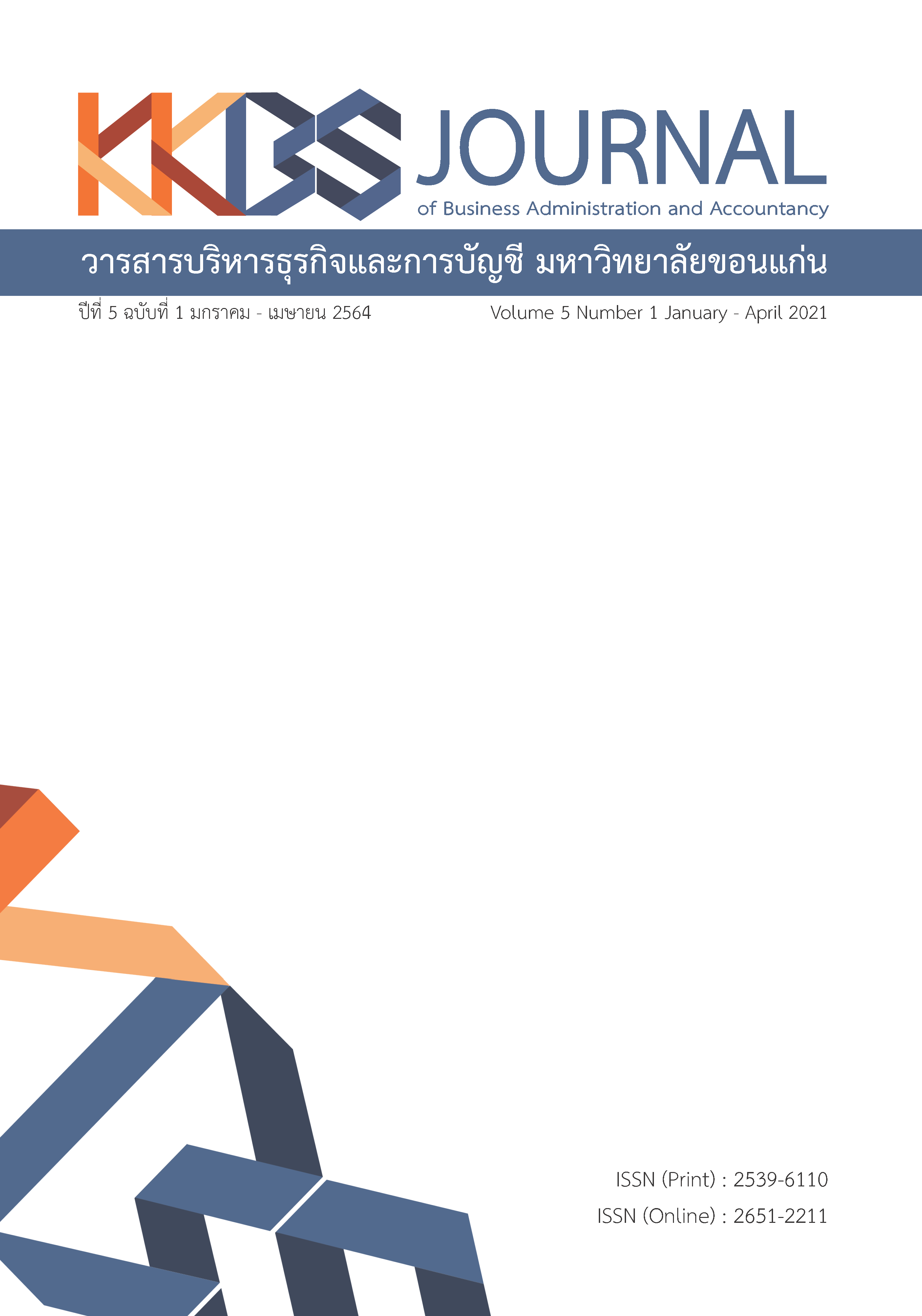ปัจจัยที่ส่งผลต่อการตอบสนองของผู้บริโภคในการโฆษณาผ่านยูทูบรูปแบบ การแทรกวีดีโอโฆษณา ของนักศึกษาในระดับปริญญาตรี มหาวิทยาลัยในประเทศไทย
Main Article Content
บทคัดย่อ
การวิจัยเชิงปริมาณ มีวัตถุประสงค์เพื่อ 1) เพื่อศึกษาความสัมพันธ์ระหว่างปัจจัยการเปิดรับโฆษณาผ่านยูทูบรูปแบบการแทรกวีดีโอโฆษณา ที่มีผลต่อทัศนคติต่อโฆษณา รูปแบบการแทรกวีดีโอโฆษณา 2) เพื่อศึกษาความสัมพันธ์ระหว่างทัศนคติต่อโฆษณาที่มีผลต่อการตอบสนองของผู้บริโภคในการโฆษณาทางยูทูบรูปแบบการแทรกวีดีโอโฆษณาของผู้บริโภคที่กำลังศึกษาในระดับปริญญาตรีมหาวิทยาลัยในประเทศไทยเก็บรวบรวมข้อมูลจากกลุ่มตัวอย่างที่ได้จากการคำนวณขนาดตัวอย่างแบบประมาณค่าสัดส่วนของประชากรกรณีไม่ทราบจำนวนประชากร(N)ได้กลุ่มตัวอย่างจำนวน 400 คนเก็บข้อมูลโดยใช้แบบสอบถามที่ผู้วิจัยสร้างขึ้น วิเคราะห์ข้อมูลโดยใช้สถิติเชิงพรรณนาและการวิเคราะห์โมเดลสมการโครงสร้างผลการวิจัยพบว่ากลุ่มตัวอย่างส่วนใหญ่เป็นเพศหญิงมีอายุเฉลี่ย20ปีที่ส่วนใหญ่กำลังศึกษาอยู่ในมหาวิทยาลัยขอนแก่นในชั้นปีที่ 4
ผลการศึกษาปัจจัยที่ส่งผลต่อการตอบสนองของผู้บริโภคในการโฆษณาผ่านยูทูบรูปแบบการแทรกวีดีโอโฆษณา7ปัจจัยพบว่าปัจจัยความน่าเชื่อถือปัจจัยความเฉพาะบุคคลและปัจจัยกิจกรรมมีอิทธิพลในเชิงบวกต่อทัศนคติต่อการโฆษณาส่วนปัจจัยการรบกวนสร้างความรำคาญและปัจจัยช่วงเวลามีอิทธิพลในเชิงลบต่อทัศนคติต่อการโฆษณาและปัจจัยที่ไม่มีอิทธิพลต่อทัศนคติต่อการโฆษณาคือปัจจัยการรับรู้ข้อมูลข่าวสารและปัจจัยความบันเทิง ในปัจจัยทัศนคติต่อการโฆษณามีอิทธิพลในเชิงบวกต่อการตอบสนองของผู้บริโภคเพื่อนำปัจจัยที่ได้ไปใช้เป็นแนวทางประกอบการตัดสินใจแก่ผู้ประกอบธุรกิจในการวางแผนพัฒนากลยุทธ์การผลิตโฆษณาทางยูทูบให้สอดคล้องกับพฤติกรรมผู้บริโภค
Article Details
บทความที่ได้รับการตีพิมพ์ในวารสารเป็นความคิดเห็นของผู้เขียน มิใช่ความคิดเห็นของกองบรรณาธิการและคณะผู้จัดทำวารสาร และบทความที่ได้รับการตีพิมพ์เป็นลิขสิทธิ์ของวารสารบริหารธุรกิจและการบัญชี มหาวิทยาลัยขอนแก่น
เอกสารอ้างอิง
Abowd, G. et al. (1999). Towards a better understanding of context and context-awareness. Berlin: Springer.
Areepermporn, P. (2018). Youtube 75 % of Thai people listen to music - watch previous movies. Retrieved January 21, 2001, from: https://thestandard.co/youtube-thai-listen-to-music-watch-tv-most (In Thai)
Baek, T.H. & Morimoto, M. (2012) Stay away from me: Examining the determinants of consumer avoidance of personalized advertising. Journal of Advertising, 41, 59-76.
Belch, G.E. & Belch, M.A. (1993). Introduction to advertising and promotion: An integrated communication perpective. Boston: Irwin.
Bleier, A. & Eisenbeiss, M. (2015). The importance of trust for personalized online advertising. Journal of Retailing, 91(3), 390–409
Boateng, H. & Okoe, A.F. (2015). Consumers’ attitude towards social media advertising and their behavioural response: The moderating role of corporate reputation. Journal of Research in Interactive Marketing, 9(4), 299–312.
Brackett, L.K. & Carr, B.N. (2001). Cyberspace advertising vs. other media: Consumer vs. mature student attitudes. Journal of Advertising Research, 41(5), 23–32.
Chon, Y.et al. (2011). Mobility prediction-based smartphone energy optimization for everyday location monitoring. In SenSys 2011 - Proceedings of the 9th ACM Conference on Embedded Networked Sensor Systems. (pp. 82–95)
Cronbach, L. (1952). Coefficient alpha and the internal structure of tests. Psychomerika, 16, 297-334.
Daems, K. et al. (2019). Personalized and cued advertising aimed at children. Young Consumers, 20(2), 138–151.
Dehghani, M. et al. (2016). Evaluating the influence of YouTube advertising for attraction of young customers. Computers in Human Behavior, 59, 165–172.
Diamantopoulos, A. & Siguaw, J.A. (2000). Introduction to LISREL: A guide for the uninitiated. London: SAGE.
Dianoux, C., Linhart, Z. & Vnouckova, L.(2014).Attitude toward advertising in general and attitude toward a specific type of advertising: A first empirical approach. Journal of Competitiveness, 6(1), 87–103.
Dix, S. et al. (2012). Facebook versus television: Advertising value perceptions among females. Journal of Research in Interactive Marketing, 6(3), 164–179.
Drossos, D., Giaglis, G & Lekakos, G. (2007). An empirical assessment of factors that influence the effectiveness of SMS advertising. Hawaii: Proceedings of the Annual Hawaii International Conference on System Sciences.
Ducoffe, R.H. (1996). Advertising value and advertising on the Web. Journal of advertising Research, 36(5), 21-35.
Duffett, R.G. (2015). Facebook advertising’s influence on intention-to-purchase and purchase amongst millennials. Internet Research, 25(4), 498–526.
El Ashmawy, M. & El Sahn, F. (2014). Measuring university student’s attitude towards Facebook advertising. The Macrotheme Review, 3(9), 40–55.
Fishbein, M. & Ajzen, I. (1975). Belief, attitude, intention, and behavior: An introduction to theory and research. Reading, MA: Addison-Wesley.
Florenthal, B. (2019). Young consumers’ motivational drivers of brand engagement behavior on social media sites: A synthesized U&G and TAM framework. Journal of Research in Interactive Marketing, 13(3), 351–391.
Göbel, F. et al. (2017). Consumer responses to covert advertising in social media. Marketing Intelligence and Planning, 35(5), 578–593.
Hair, J.F. et al. (2010). Multivariate data analysis. 7th ed. Upper Saddle River, NJ.: Prentice Hall.
Halalau, R. & Kornias, G. (2012). Factors influencing users attitude toward display advertising on Facebook. Sweden: Jonkoping International Business School.
Hamouda, M. (2018). Understanding social media advertising effect on consumers’ responses: An empirical investigation of tourism advertising on Facebook. Journal of Enterprise Information Management, 31(3), 426–445.
Katz, E., Blumler, J.G. & Gurevitch, M. (1959). Uses and gratifications research. The Public Opinion Quarterly, 37(4), 509-532.
Kaplan, G. (2012). Inequality and the life cycle. Quantitative Economics, 3, 471-525.
Kim, Y. & Han, J. (2014). Why smartphone advertising attracts customers: A model of web advertising, flow, and personalization. Computers in Human Behavior, 33, 256-269.
Lee, J.E. & Watkins, B. (2016). YouTube vloggers’ influence on consumer luxury brand perceptions and intentions. Journal of Business Research, 69(12), 5753–5760.
Likert, R. (1952). A technique for the development of attitude scales. Educational and Psychological Measurement, 12, 313- 315.
Luo, X. (2002). Uses and gratifications theory and e-consumer behaviors: A structural equation modeling study. Journal of Interactive Advertising, 2(2), 34-41.
Mahittivanicha, N. (2019). Social media today 2019. Retrieved June 21, 2019, from: https://www.twfdigital.com/blog/2019/06/youtube-stat-june2019 (In Thai)
Mahittivanicha, N. (2019). Around social (2019). Retrieved August 22, 2019, from:
https://www.twfdigital.com/blog/2019/08/global-digital-usage-stat-and-behaviour-q3-2019/ (In Thai)
Mahmoud, B. (2013). PrivComp: A Privacy-aware data service composition system. ACM International Conference Proceeding Series, 757-760.
Nipa Digital Marketing. (2019). Know the types of YouTube ads before choosing them correctly. Retrieved June 21, 2019, from: https://nipa.co.th/th/about-us
Onkaew, N. & Wongpinunwatana, N. (2015) The study of the influential factors of the consumers towards the products and services advertised in Line official account. Journal of Information System in Business, 1(1), 43-58. (In Thai)
Onjun, P. (2017). Media exposure and response to true view in-stream advertisement on YouTube of gen M. Bangkok: Bangkok University.
Partridge, K. & Begole, B. (2011). Activity-based advertising: Techniques and challenges. pp. 83–101. In Muller, J. et al. Pervasive advertising. London: Sage.
Sigmund, K. et al. (2010). Social learning promotes institutions for governing the commons. Nature, 466, 861-863.
Strong, E. (1925). The psychology of selling. New York: MacGraw-Hill.
Tabachnick, B.G. & Fidell, L.S. (2007). Using multivariate statistics. 5th ed. Hoboken, NJ.: Pearson Education.
Wang, C. et al. (2002). Understanding consummers attitude toward advertising. Texas: AMCIS.
Wang, Y. & Gen, E. (2019). Path to effective mobile advertising in Asian markets: Credibility, entertainment and peer influence. Asia Pacific Journal of Marketing and Logistics, 31(1), 55–80.
WP. (2019). Global digital 2019. Retrieved February 23, 2019, from: https://www.marketingoops.com/reports/global-and-thailand-digital-trend-2019/ (In Thai)
Wittawin, A. (2019). Platfrom Youtube 2019. Retrieved March 21, 2019, from: https://www.thumbsup.in.th/youtube-stats-2019/ (In Thai)
Wongreanthong, N. (2019). Digital marketing. Retrieved January 1, 2019, from: https://www.nuttaputch.com/marketing-in-2019/ (In Thai)
Yengobuzz. (2019). Digital community 2019. Retrieved June 10, 2019, from: http://www.yengobuzz.com/
Zabadi, A.M.A., Shura, M. & Elsayed, E.A. (2012). Consumer attitudes toward SMS advertising among Jordanian users. International Journal of Marketing Studies, 4(1), 77–94.
Zimbardo, P.G. & Ebbesen, E.B. (1970). Experimental modification of the relationship between effort, attitude, and behavior. Journal of Personality and Social Psychology, 16(2), 207–213.


